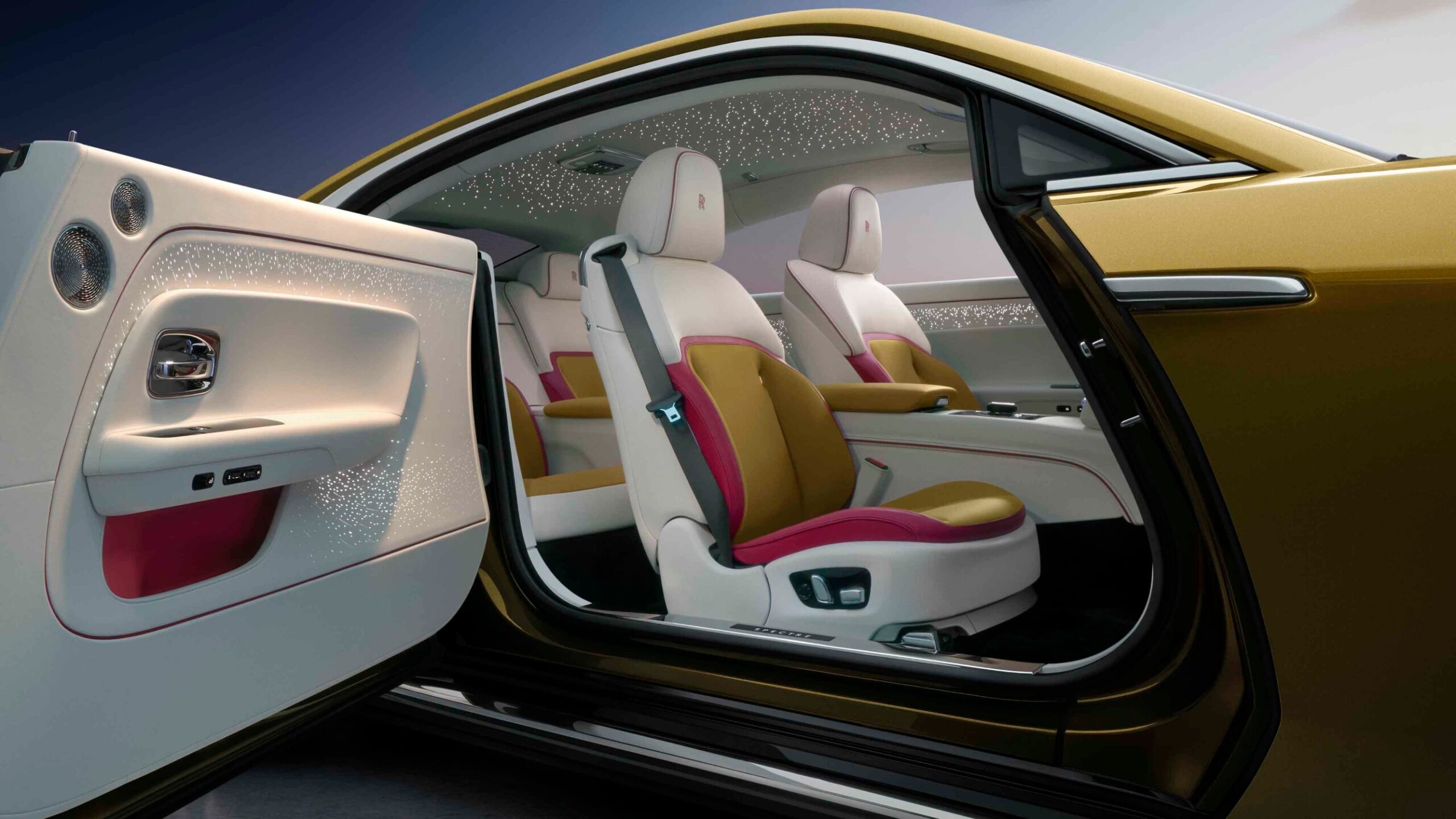In 1900, the co-founder of Rolls-Royce, Charles Rolls, bought an electric vehicle called the Columbia Electric Carriage. It was the start of an ambition to create a car that was as quiet as possible for its occupants, although for the next 123 years that ambition had to be achieved using the internal combustion engine.
“The electric car is perfectly noiseless and clean,” said Rolls at the time. “There is no smell or vibration. They should become very useful when fixed charging stations can be arranged.”
We have, of course, reached that point and that is why in 2021, the CEO of Rolls-Royce, Torsten Müller-Ötvös, announced that the luxury auto maker would produce its first battery-electric model. That car is the Spectre and it follows early experiments with electric propulsion in the Rolls-Royce 102EX of 2011. That was just a concept, but Spectre is a full production model that uses powertrain expertise from across the BMW Group.
“This is a cooperation between the BMW engineers and Rolls-Royce engineers,” says Mihiar Ayoubi, Rolls-Royce’s director of engineering. “We are utilizing the biggest battery within this cooperation. We contributed with our experience and our specifications and we validated the drivetrains together.” 
Ayoubi is reluctant to confirm final output numbers, although the battery pack is the largest in the BMW Group and expected to produce around 106kWh. In 2022 BMW announced its next-generation electric vehicle architecture, Gen 6, which will switch from prism to cylindrical batteries. However, for Spectre, Ayoubi chose to stick with the Gen 5 prism batteries.
“We started looking at the requirements of the customers in terms of how often do they want to charge, what mileage do they drive and what’s the optimal setup for them,” he says. “We ended up talking about the drivetrain’s lifetime consideration in terms of warranty, durability, quality and safety. Then we decided to choose the best up-to-date techniques available at this time and, most of all, to have the mainstream infrastructure outside. We decided to utilize the Gen 5.”
This also means a 400V architecture rather than opting for 800V. “We consider it as advantageous at this time, because it’s the most available for our customers,” Ayoubi says. “If you have the 800V on board you need to search for superchargers so it’s not practical at all. In addition to that, if you want to charge at a 400V charger and you have an 800V battery, you need quite complex converters so it’s senseless.”
Discussions with existing customers revealed that many already have an electric vehicle charger at their home or at their workplace and it made sense to fit with their existing lifestyle rather than expect them to change how they charge.
Pick-and-mix powertrain
Spectre uses two electric motors, one on each axle, to provide all-wheel drive. Again, they have been selected from within the BMW Group and will provide a combined output of 577bhp and 900Nm of torque. Rolls-Royce has not committed to an exact driving range figure yet, with final development and testing still ongoing, but it has stated it will be approximately 515km.
Opting for existing powertrain components from within the group has made things easier, but Ayoubi says the main challenge was adapting the overall vehicle architecture to accommodate the switch to electric. It is still based on the aluminum space frame that Rolls-Royce refers to as its Architecture of Luxury, which underpins other models like the Ghost, Cullinan and the latest Phantom, but it needed significant reworking for Spectre, something that Ayoubi says was more straightforward than might have been expected.
“The main topic was the flexibility of the architecture in order to hand-in-glove fit the battery and the electric motors in the car,” he says. “This was the biggest advantage because actually building electrical drivetrains isn’t an issue – it’s quite simple, it simplifies car development. However, the main engineering target was to exceed the specifications of the existing Rolls-Royce of today and we have achieved that.”
One of the first things the engineering team did was to raise the floor, the obvious reasons being in order to accommodate the battery pack and achieve a lower center of gravity in what is being billed by the marque as a super coupe. Another consideration was what Ayoubi calls the deflection line, essentially the torsional stiffness between the front and rear of the car. He says this line is relatively soft in many other electric vehicles due to the stiffness of the battery pack, and it was vital to get this right in the Spectre to deliver the ‘waftability’ typical of a Rolls-Royce.

The Rolls signature
The term waftability is not one you might normally hear from an engineer, and Ayoubi admits it is one coined by the marketing department. However, he says it is perfectly apt for the car.
“It really describes what happens when you drive the car. The car is flowing, it’s a kind of magic,” he says. The driver should be aware they are driving over bumps in the road but they should not be able to feel them. However, that doesn’t mean they lose their connection with the road; in fact, the opposite is true, with Ayoubi saying they should feel everything through the steering but without the road disturbances.
“This is one benefit of the electric drivetrain because the unsprung masses for the chassis are relative to the car mass; not negligible, but they are much better than a combustion-engine-driven car,” he explains. Switching to electric also meant a fresh approach to the operating strategy of the control systems for Spectre compared to other Rolls-Royce models. Within the aluminum structure, the team have created an entirely new electric backbone with multiple domain control systems.
“We allow them to freely interact and exchange the information of all signals available,” says Ayoubi. “This instant exchange of information allows the car to become highly connected, but also to deliver a very instant reaction to the action of the driver as well as the road.
Fit for purpose
Since the announcement in 2021 that Rolls-Royce was going to build its first electric model, engineers have been conducting what is described as the most rigorous testing program in the company’s history. It has already covered over 2,000,000km of testing in locations that include the South of France, South Africa and Arjeplog in the north of Sweden.
“The reason for our extraordinary and relentless global testing process is simple: there has never been a motor car like Spectre before,” says Mihiar Ayoubi.
“As the first all-electric Rolls-Royce, Spectre represents not just a new paradigm in our technology, but the entire future direction of our brand. Only Rolls-Royce engineers could conceive this astonishing journey, and only Rolls-Royce engineers could undertake it: the task is not to test a motor car but to elevate the benchmark of automotive excellence.”
It’s been essential to test all components in the coldest and hottest environments, as well as differing road conditions. While there has been a focus on the luxury components, for the first time Rolls-Royce engineers have had to test electric drivetrain components across different climates. This has included 1,500 hours of regenerative braking tests and, more importantly than ever, NVH testing to account for the near-silent running of the electric motor.

Lofty targets
“In terms of interconnecting the systems, you’re talking about thousands of algorithms which, after being developed for the car, now have to learn to behave just like a Rolls-Royce behaves – you can shape those algorithms to deliver a sporty car, but we wanted to deliver this unlimited waftability,” says Ayoubi.
Hitting that target required getting the hardware genes right first and then focusing on software applications. What did Ayoubi find were the most challenging aspects of engineering Spectre?
“The most technical challenge was to make use of the flexibility of the architecture to integrate the electric drivetrain and yet produce it on the same production line with a combustion-engine-driven Rolls-Royce, which is taking place at Goodwood. This to me was the most demanding topic we started with, but we also had to forget about delivering an electric car, it was about delivering a Rolls-Royce.”


